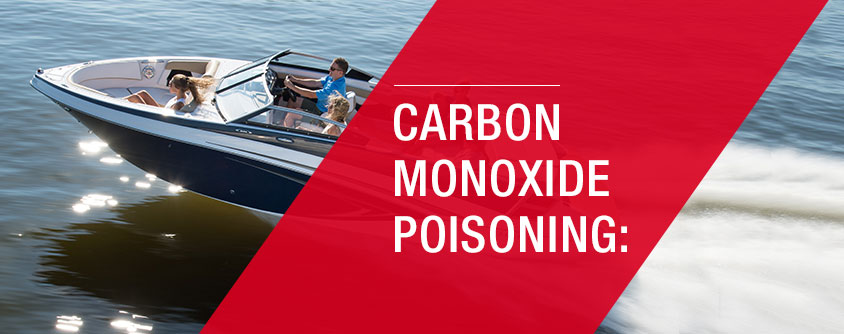
...CAN harm you.
Carbon monoxide (CO) is a colorless, odorless, and tasteless gas. It is produced when a carbon-based fuel—such as gasoline, propane, charcoal, or oil—burns.
CO sources on your boat may include engines, gas generators, cooking ranges, propane/charcoal grills, and space and water heaters. Even engines with catalytic converters produce some CO.
Carbon monoxide enters your bloodstream through the lungs, blocking the oxygen your body needs. Prolonged exposure to low concentrations or short exposure to high concentrations can kill you.
Early symptoms of CO poisoning include irritated eyes, headache, nausea, weakness, and dizziness. These symptoms are often confused with seasickness or intoxication, so those affected may not receive the medical attention they need.
A: ANYWHERE in or around your boat.
- CO can harm and even kill you inside or outside your boat.
- CO can affect you whether you’re underway, moored, or anchored.
- CO symptoms are similar to seasickness or alcohol intoxication.
- You cannot see, smell, or taste CO, but if you smell exhaust fumes, CO is present.
- CO can make you sick in seconds. In high enough concentrations, even a few breaths can be fatal.
- Know the signs of CO poisoning.
- Treat symptoms of seasickness as possible CO poisoning.
- Get the person into fresh air immediately. Seek medical attention—unless you’re sure it’s not CO.
- Know where and how CO may accumulate in and around your boat.
- Know where your engine and generator exhaust outlets are located and keep everyone away from these areas.
- Stay off the back deck and the swim platforms (and do not use a hand-held shower in these areas) while the engines and/or generators are running.
- Never swim under or into air pockets or areas under swim platforms where exhaust outlets are located.
- If exhaust fumes are detected, or if CO accumulation is suspected on the boat, take immediate action to ventilate these fumes. Turn off all engines and/or generators and open all hatches, windows and ports to ventilate.
- If you can smell engine or generator exhaust, you are inhaling CO.
- CO can also be present without the smell of exhaust fumes.
- Changing course and speed to place the boat heading into the wind can improve ventilation.
- Maintain fresh air circulation throughout the boat at all times.
- Install and maintain approved marine-grade CO detectors.
- Every alarm requires immediate action.
- Maintain your engine and/or generator in accordance with manufacturers' recommendations. Engines and generators that are not tuned properly produce more CO.
- Follow all warnings and instructions for canvas, engine, generator and blower operations, etc.
- Follow the checklists provided in this pamphlet
- Educate all passengers about the symptoms of CO poisoning and where CO may accumulate.
- Confirm that water flows from the exhaust outlet when the engines and generator are started.
- Listen for any change in exhaust sound, which could indicate an exhaust component failure.
- Look for exhaust leaking from exhaust system components.
Note: Engine room bulkheads may not prevent leaking exhaust from entering the boat cabin. - When docked or rafted with another boat or boats, be aware of exhaust emissions from the other boat(s).
Note: Be aware of the location of exhaust exits (side or transom) to prevent restriction in exhaust flow. - Every time you boat, test the operation of each CO detector by pressing the test button. CO detectors have a limited life; replace as directed by the manufacturer
Note: Applies to both engines and generators
- Inspect rubber exhaust hoses for burned, cracked, or deteriorated sections and replace if damaged.
- Check engine compartment ventilation for blockage that may obstruct free airflow.
- Inspect raw water strainers for debris and clean if necessary.
Note: Applies to both engines and generators
- Check expiration date of CO detector and replace if necessary.
- Ensure that your engines and generators are properly tuned and well maintained.
- Inspect each water pump impeller and the water pump housing to ensure cooling systems are working properly. Worn impellers can lead to heat buildup and exhaust hose failure.
- Inspect all metallic exhaust components, including the cylinder head gasket, exhaust manifold, water injection elbow, and the threaded adapter between the manifold and the elbow, for cracking, rusting, leaking, or loosening.
- Inspect all metallic exhaust components for corrosion, especially bronze or brass fittings coated with copper oxide.
- Clean, inspect, and confirm proper operation of the cooling water anti-siphon valve (if so equipped).
- Check each hose clamp for tightness and corrosion.
Office of Auxiliary and Boating Safety
Commandant (CG-BSX-2) Stop – 7501
2703 Martin Luther King Jr. Ave., S.E.
Washington, DC 20593-7501
uscgboating.org
202.372.1062
231 S. LaSalle Street, Suite 2050
Chicago, IL 60604
nmma.org
312.946.6200
613 Third Street, Suite 10
Annapolis, MD 21403
abycinc.org
410.990.4460
